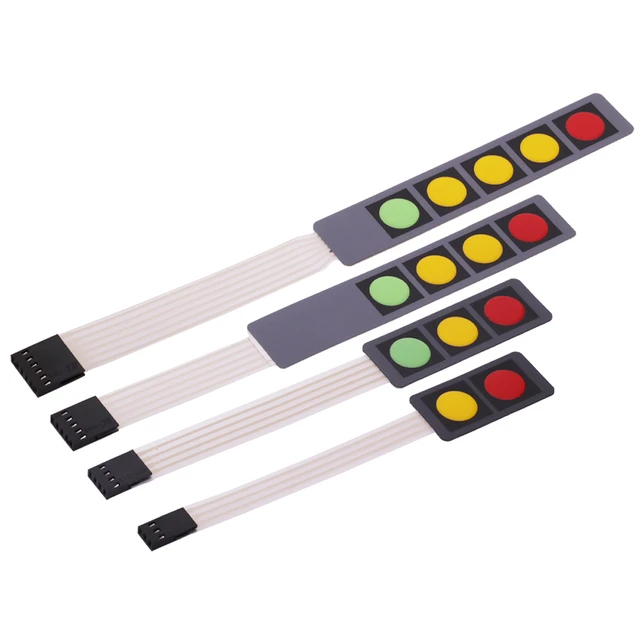How Membrane Switches Are Shaping the Future of Electronic Interfaces
Recognizing Membrane Layer Changes: The Trick to Durable and Reliable Controls

What Are Membrane Switches?
Membrane buttons are an innovative remedy in the realm of user interface innovation, integrating functionality and design seamlessly. These gadgets work as a user interface between users and digital systems, integrating several elements into a portable style. Commonly constructed from adaptable, thin layers of materials, membrane layer buttons are developed to react to touch, making it possible for individuals to connect with machinery and digital devices successfully.
The key elements of a membrane switch include a printed circuit layer, visuals overlay, and a spacer layer that stops unplanned activation. The graphic overlay can be personalized to reflect brand name identity or customer preferences, boosting looks while making sure usability. Membrane buttons are typically utilized in different applications, consisting of medical gadgets, customer electronics, and industrial tools, owing to their longevity and resistance to environmental variables such as moisture and dust.
Among the key benefits of membrane layer buttons is their ability to hold up against wear and tear, making them suitable for high-traffic settings. In addition, they are light-weight and call for marginal room, permitting ingenious styles in product growth. On the whole, membrane changes stand for a efficient and useful option for modern-day electronic interfaces, marrying modern technology with user-centric layout principles.
How Membrane Layer Changes Job
The operation of membrane switches over hinges on a basic yet effective device that translates customer input right into digital signals. When an individual presses the button, the top layer warps, enabling a conductive component in the circuit layer to make contact with a matching conductive pad on the underside of the visuals overlay.
The style of membrane layer switches can differ, yet they commonly include domes or tactile aspects to provide feedback to the customer, boosting the overall experience - membrane switch. The products made use of in membrane layer buttons, such as polyester or polycarbonate, add to their toughness and resistance to environmental aspects, including wetness and dust. Additionally, the published circuits are usually enveloped, which safeguards them from damage gradually.
Advantages of Membrane Layer Buttons

In addition, membrane layer switches are known for their longevity. Constructed from durable products, they are immune to dust, dampness, and physical wear, which substantially extends their life expectancy compared to conventional mechanical switches. This sturdiness makes them especially appropriate for high-traffic settings and applications requiring longevity.
An additional significant benefit is the convenience of cleansing and upkeep. The smooth surface area of membrane layer switches over lessens dust build-up and is commonly invulnerable to spills, making them ideal for settings that call for constant sanitization.
Furthermore, membrane switches supply a structured account, causing a thinner design that can be incorporated right into numerous gadgets without including mass. This function not only improves the visual appeal but likewise adds to a more ergonomic special info item style.
Applications of Membrane Buttons
Flexible check my site and user-friendly, membrane layer switches locate applications across a wide variety of sectors, including medical tools, customer electronic devices, and industrial equipment. In the clinical field, these buttons are important to devices such as analysis tools, patient tracking systems, and mixture pumps, where reliability and ease of cleansing are essential. Their capability to hold up against extreme environments and keep functionality makes them optimal for such applications.

In consumer electronics, membrane layer switches are used in products like microwaves, washing equipments, and push-button controls - membrane switch. Their streamlined style permits instinctive customer interfaces, boosting the general customer experience while offering longevity and resistance to tear and use
Commercial devices additionally takes advantage of membrane buttons, particularly in control panels for machinery and automation systems. These switches use protection versus dirt and dampness, ensuring constant efficiency in difficult environments. Their customizable features allow manufacturers to tailor them to details operational needs, enhancing efficiency and functionality.
Picking the Right Membrane Layer Switch
When choosing a membrane switch, it is necessary to think about different elements that influence efficiency and viability for certain applications. The main considerations include ecological problems, tactile feedback, sturdiness, and design specifications.
First, assess the operating atmosphere; switches exposed to wetness, chemicals, or extreme temperatures call for certain materials to ensure long life and functionality. Next, review the requirement for tactile responses. Relying on individual communication, some applications may gain from a responsive reaction to validate activation, while others might choose a non-tactile layout for aesthetic reasons.
Sturdiness is another essential aspect; membrane buttons ought to be made to endure constant use, influences, and abrasion. Make sure the selected button can endure the expected lifecycle, particularly in high-usage situations.

Verdict
To conclude, membrane switches act as vital components in the layout of sturdy and trustworthy control systems across numerous markets. Their portable style, combined with durable construction and customizable attributes, boosts individual communication while making sure durability popular environments. The versatility of membrane layer switches permits tailored options that meet certain functional requirements, reinforcing their relevance in modern innovation. As sectors continue to advance, the significance of incorporating effective membrane layer button services can not be overemphasized.
Membrane changes stand for a critical aspect of modern user interface style, blending capability with strength in numerous applications.Membrane layer switches are a sophisticated solution in the world of customer interface modern technology, combining functionality and design perfectly. Usually built from versatile, slim layers of products, membrane layer visit buttons are created to react to touch, allowing individuals to communicate with machinery and electronic devices efficiently.
The design of membrane buttons can differ, yet they usually include domes or responsive elements to provide responses to the customer, improving the general experience.In conclusion, membrane switches over serve as vital parts in the style of dependable and sturdy control systems throughout numerous markets.